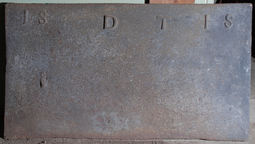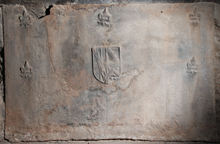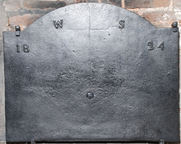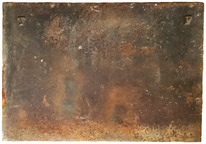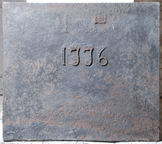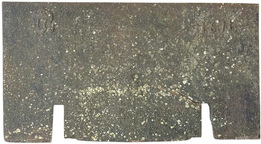-
331
Description: Rectangular; no edging; inscription evenly spaced along top, sans serif lettering.
Inscription: IS D T IS
- Decoration tags:
- rectangular (shape)
- none (edging)
- carved stamps
- individual letters
- text
Manufactured: in the late-19th to early-20th century in England.
Current location: Horsham Museum, Causeway, Horsham, West Sussex, England.
(part of the Horsham Museum museum group)
- Attached to series:
- Initials only firebacks
-
951
Description: Rectangular; central shield; fleur-de-lys stamp repeated three times across top and once on each side level with shield, all regularly spaced.
Notes: It is likely that the arms relate to the marriage, in 1541, of Christopher Sackville (c.1519-1559), son of John Sackville of Chiddingly, Sussex, and Constance Colepeper, daughter of Thomas Colepeper of Bedgebury, Kent, one of whose ancestors was the heiress, Elizabeth Hardreshull. The blazon: Sackville - quarterly or and gules, a bend vair; Colepeper - argent a bend engrailed gules; Hardreshull - argent a chevron sable between nine martlets gules, six and three. Christopher Sackville's brother, Sir Richard, owned Horsted Keynes furnace, which may have been where this fireback was cast. A candidate for the earliest English fireback with an example of personal arms.
Arms: Sackville impaling Colepeper and Hardreshall
- Decoration tags:
- rectangular (shape)
- none (edging)
- carved stamps
- heraldic
- armorial
Manufactured: in the mid-16th century possibly at Horsted Keynes Furnace in the Weald area of England.
Current location: in private hands, Horsted Keynes, West Sussex, England.
- Attached to series:
- Personal armorial firebacks
- Sackville firebacks
-
343
Description: Arched rectangular shape; no edging; initials evenly spaced around arch; date split between top corners.
Inscription: W S / 18 24
- Decoration tags:
- rectangular with round arch (shape)
- none (edging)
- individual letters
- individual numbers
- text
Manufactured: in 1824 in England.
Current location: Ightham Mote, Ightham, Kent, England.
Museum number: 825375 (part of the National Trust museum group)
- Attached to series:
- Date & initials firebacks
-
1250
Description: Plain rectangular shape; no edging; separate initials in top left corners.
Notes: The regular form of the letters suggest that they might be reused printing blocks.
Inscription: T F
- Decoration tags:
- rectangular (shape)
- none (edging)
- carved stamps
- text
Manufactured: in the 19th century in England.
Current location: in private hands, Isleworth, London, England.
- Attached to series:
- Initials only firebacks
-
362
Description: Rectangle; no edging; date just above centre; initials above date.
Notes: The disparity between the quality of the stamping of the date and initials may be because the date has been stamped from a single block. There are stylistic similarities with the memorial plate to John and Ann Luck, dated 1771, in Wadhurst church porch, Sussex.
Inscription: I H / 1776
- Decoration tags:
- rectangular (shape)
- none (edging)
- carved stamps
- individual letters
- individual numbers
- text
Manufactured: in 1776 in the Weald area of England.
Current location: Scotney Castle, Lamberhurst, Kent, England.
Museum number: 791899 (part of the National Trust museum group)
- Attached to series:
- Date & initials firebacks
-
1309
Description: Rectangular shape; no edging; top left, inverted 'renaissance' shield with the initials M above IE; top right, date 1671 in unseriffed numerals.
Notes: The shield with initials has not been noted on another fireback. The slots in the fireback are to accommodate andirons or firedogs.
Inscription: IME [triad] 1671
- Decoration tags:
- rectangular (shape)
- none (edging)
- carved stamps
- individual numbers
- text
Manufactured: in 1671 in England.
Current location: Lay's Auctioneers, Alverton Road, Penzance, Cornwall, England.
- Attached to series:
- Date & initials firebacks
- Andiron slot firebacks
-
380
Description: Damaged rectangular plate; no edging; a buckle stamp repeated eight times in alternate horizontal and vertical pairs in four columns.
Notes: The buckle closely resembles that used to decorate glazed bricks on the walls of Laughton Place, Sussex, built by Sir William Pelham in 1534.
- Decoration tags:
- rectangular (shape)
- none (edging)
- carved stamps
- heraldic
- objects
Manufactured: in the early- to mid-16th century in the Weald area of England.
Current location: Anne of Cleves House, Southover High Street, Lewes, East Sussex, England.
Museum number: LH000.912 (part of the Sussex Archaeological Society museum group)
- Attached to series:
- Pelham family firebacks
-
385
Description: Rectangular with two-stepped top; plain plate; date across lower step; rope saltire in upper step; initials split below outer shoulders.
Notes: The distinctive hand-formed characters on this and some other stepped firebacks imply a common source. Although the talbot crest, by which other firebacks in the series are identified, is absent on this casting, the shape and the style of the characters places it incontrovertably in the same group. Formerly part of the J. H. Every collection.
Inscription: 1615 / R T
- Decoration tags:
- stepped (shape)
- none (edging)
- simple stamps
- individual letters
- individual numbers
- text
- objects
Manufactured: in 1615 in the Weald area of England.
Current location: Anne of Cleves House, Southover High Street, Lewes, East Sussex, England.
Museum number: 1944.24.050 (part of the Sussex Archaeological Society museum group)
Citation: Anon., 30 Dec 1911, 'Sussex Backs and their Story', The Ironmonger.
Citation: Hughes, G. B., 21 Apr 1955, 'Old English Firebacks', Country Life, 117, pp. 1056-60.
Citation: Hughes, G. B., May 1940, 'Old English Firebacks', Apollo, 31, 185, pp. 117-120.
- Attached to series:
- Stepped firebacks
- Talbot crest series
-
402
Description: Rectangular with pediment and frieze resting on fluted Tuscan pilasters; plain podium base; rectangular central panel with double fillet edge divided into four with central panel containing initials; date in tympanum.
Notes: An early example of the use of classical architectural elements in an English fireback. Formerly part of the J. H. Every collection.
Copies of this fireback are known.
Inscription: [1]568 / ER
- Decoration tags:
- rectangular with pediment (shape)
- none (edging)
- whole carved pattern
- architectural
- text
Manufactured: in 1568 in the Weald area of England.
Current location: Anne of Cleves House, Southover High Street, Lewes, East Sussex, England.
Museum number: 1944.24.062 (part of the Sussex Archaeological Society museum group)
- Attached to series:
- 1568 Architectural series
-
428
Description: Rectangular, with low curved top and stepped concave corners; suspended floral-chain border on top and sides; alternate small and large rings along the bottom; plain panel at base. Arms of Webster, baronet, of Battle: Azure, on a bend argent, cotised Or, between two demi-lions ermine, a rose gules, barbed and seeded proper, between two boars’ heads couped sable.
Notes: Sir Thomas Webster was created baronet in 1703; he was succeeded by his son, Whistler, in 1750. A pair of matching, cast-iron side plates form a set with this fireback.
Copies of this fireback are known.
Arms: Webster of Battle
- Decoration tags:
- rectangular with canted top corners and round arch (shape)
- none (edging)
- whole carved pattern
- armorial
Manufactured: in the early-18th century possibly at Robertsbridge Furnace, Salehurst in the Weald area of England.
Current location: Barbican House, High Street, Lewes, East Sussex, England.
Museum number: 39.52/LH000.986 (part of the Sussex Archaeological Society museum group)
- Attached to series:
- Personal armorial firebacks
